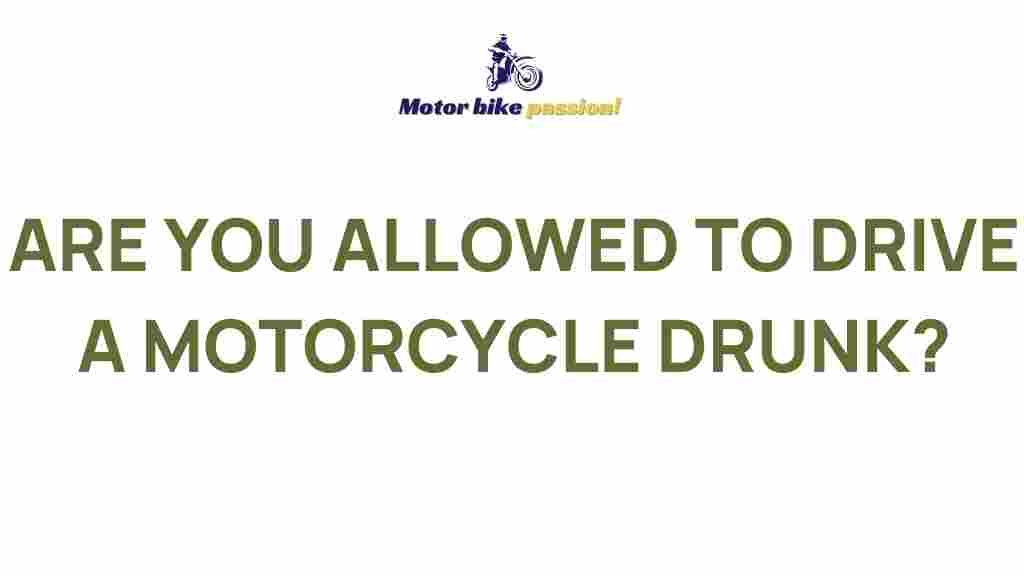The Impact of Riding a Motorcycle Under the Influence of Alcohol
Motorcycles are a thrilling mode of transportation, offering freedom and exhilaration on the open road. However, riding a motorcycle comes with significant risks, especially when alcohol enters the picture. Operating any vehicle under the influence is dangerous, but motorcyclists are particularly vulnerable due to the lack of physical protection.
This article explores the dangers of riding a motorcycle while intoxicated, the physiological and legal implications, and actionable steps to prevent alcohol-related accidents.
Why Alcohol Impairs Motorcycle Riders
Alcohol consumption directly affects the central nervous system, impairing cognitive and motor functions. This creates a deadly combination for motorcyclists who require balance, quick reflexes, and heightened awareness. The following are key ways alcohol impairs a rider:
- Delayed Reaction Times: Alcohol slows down the ability to react to obstacles or sudden changes on the road.
- Reduced Balance: Maintaining balance is critical for a motorcycle, and alcohol disrupts this coordination.
- Impaired Judgment: Riders under the influence are more likely to take unnecessary risks or misjudge distances.
- Blurred Vision: Alcohol can cause double vision or difficulty focusing, making it harder to navigate safely.
Statistics Highlighting the Danger
According to the National Highway Traffic Safety Administration (NHTSA), motorcyclists accounted for 27% of alcohol-impaired traffic fatalities in recent years. This is significantly higher than drivers of other vehicles. Additionally, over 40% of motorcycle riders killed in crashes had blood alcohol concentrations (BAC) exceeding the legal limit of 0.08%.
These alarming figures demonstrate the urgent need to address the problem and educate motorcyclists about the risks associated with riding under the influence.
How Alcohol Affects Riding a Motorcycle
Let’s break down the progressive effects of alcohol consumption on motorcyclists based on BAC levels:
- 0.02% BAC: Minor effects like relaxation and slight loss of judgment.
- 0.05% BAC: Noticeable impairment in coordination, tracking, and steering skills.
- 0.08% BAC: Legal intoxication; significant difficulty with balance, vision, and reaction times.
- 0.15% BAC and above: Severe impairment, complete loss of motor control, and extreme danger to self and others.
Steps to Avoid Riding a Motorcycle While Intoxicated
Preventing alcohol-related motorcycle accidents requires planning and discipline. Here’s a step-by-step guide to staying safe:
Step 1: Plan Ahead
If you know you’ll be consuming alcohol, arrange alternative transportation options beforehand. This could include:
- Using a rideshare app or taxi service.
- Designating a sober friend or family member as your driver.
- Utilizing public transportation where available.
Step 2: Know Your Limits
Everyone metabolizes alcohol differently, but even small amounts can impair your ability to safely operate a motorcycle. Familiarize yourself with your limits and avoid riding after even one drink.
Step 3: Rely on Peer Accountability
Riding with friends? Hold each other accountable. Encourage fellow riders to stay sober or take turns being the designated driver. Group responsibility can significantly reduce the chances of impaired riding.
Step 4: Use Alcohol Monitoring Tools
Personal breathalyzers or smartphone apps can help you determine your BAC before getting on your motorcycle. While these tools aren’t foolproof, they provide an added layer of caution.
Step 5: Stay Informed About Legal Consequences
Driving under the influence laws are strict, and for good reason. Familiarize yourself with local regulations and the penalties for riding a motorcycle while intoxicated, which often include:
- Hefty fines.
- License suspension or revocation.
- Mandatory alcohol education programs.
- Possible jail time.
How to Handle a Potentially Impaired Rider
If you suspect a friend or fellow motorcyclist is considering riding while intoxicated, take proactive measures:
- Offer Alternatives: Suggest they leave their bike behind and use alternative transportation.
- Take the Keys: Secure their motorcycle keys until they’re sober.
- Call for Help: Enlist others to help convince the rider to avoid endangering themselves and others.
Overcoming the Stigma
For many riders, the independence associated with motorcycles can make it challenging to accept assistance. Emphasize that taking precautions isn’t a sign of weakness but a demonstration of responsibility.
Conclusion: The Road to Safer Riding
Riding a motorcycle under the influence of alcohol is a preventable tragedy waiting to happen. By understanding the risks, planning ahead, and fostering a culture of accountability, we can reduce alcohol-related accidents and make the roads safer for everyone.
For more tips on motorcycle safety, check out our comprehensive guide. Together, let’s ensure that the thrill of the ride is never overshadowed by preventable consequences.
Learn more about alcohol-impaired driving statistics and prevention at MADD (Mothers Against Drunk Driving).
This article is in the category Safe Driving and created by MotorBikePassion Team

3 thoughts on “Unveiling the Dangers: Riding Under the Influence of Alcohol”